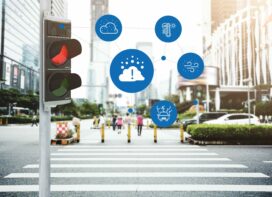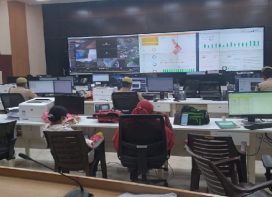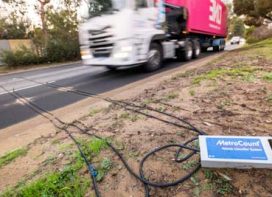 Road Safety is one of the most discussed issues in the world today. What is the situation in Bhopal (Madhya Pradesh) on this issue?
Road Safety is one of the most discussed issues in the world today. What is the situation in Bhopal (Madhya Pradesh) on this issue?
I will begin by giving you some figures. Out of the world’s 1.2 million fatal road accidents, India accounts for 114590 and Madhya Pradesh, 5,598 whereas in non-fatal accidents, the numbers are 50 million, 8,59,425 and 27, 332 respectively. From 2001 to 2006, the accidents have risen in MP from 26239 to 32931. When it comes specifically to the Bhopal district, the figure, as in 2008, was 263 and 3305 in fatal and non fatal accidents. Against this scenario, I cannot say the situation looks good.
So what problems does the city face in tackling this alarming situation?
Many factors contribute to the situation. The increasing population and vehicular density come right at the top. Then, there is an urgent need to go in for infrastructural development activities like building flyover, etc. The delay in land acquisition for the widening of roads too acts as a stumbling block. There are problems like encroachments and obstructions on carriageways which hinder pedestrian pavements. We too face an acute shortage of parking space – just liPke it is faced anywhere else in the country or even, the world. Then, there are bus breakdowns, major road digging activities, poor road engineering, slow response to emergency situations and daytime maintenance activities which all hinder the management process. You also cannot ignore the attitude of people and even the social customs that quite often use the road space for their successful completion. Overall, the infrastructure is incomplete.
Why is the response to emergency situations slow? And how can it be tackled if it can be tackled at all?
There is a need for integrated emergency services at all district levels which would bring in all the important services like fire, ambulance and the police together to provide real-time emergency service to the citizens. The MP Government is working towards this and soon, the service would be launched.
 When we talk of encroachment and obstructions on carriageways, it must also be leading to inter-departmental issues as traffic management is your responsibility but carriageways and encroachment are responsibilities of other government departments. Does this too add to your woes or lead to delays?
When we talk of encroachment and obstructions on carriageways, it must also be leading to inter-departmental issues as traffic management is your responsibility but carriageways and encroachment are responsibilities of other government departments. Does this too add to your woes or lead to delays?
The encroachment is a Municipal Corporation issue and Police has no role to play in this. Having said that, I would also like to add that review meetings are held regularly at the district Head Quarters to overcome this problem. It’s a complex issue and needs to be handled very carefully. The stakeholders are doing their best to solve the issue.
So, how important is proper and scientific traffic management? What does it entail?
I think there are four Es that will lead to the success of any traffic management exercise – Evaluation; Engineering; Education; and Enforcement.
There is a need for public partnership in all the initiatives the traffic police undertakes as the road users have a very important role to play in the entire process they have to work very closely in addressing the traffic related issues. Also, education on traffic at school and college levels is very important.
What is the CCTNS project? What are your objectives for Bhopal as the nodal officer to handle this critical mission mode project?
Crime and Criminal Tracking Network and Systems (CCTNS) is a Mission Mode Project (MMP) conceptualised and sponsored by the Ministry of Home Affairs (MHA), Government of India (GOI) towards enhancing the outcomes in Crime Investigation and Criminal Tracking; and, in enhancing the efficiency and effectiveness of police departments in all the states.
CCTNS aims at creating a comprehensive and integrated system for enhancing the efficiency and effectiveness of policing at all levels, specially at the police station level. This is done through the adoption of the principles of E-Governance and creation of a nationwide network infrastructure for evolution of IT enabled state-of-the-art tracking system around investigation of crime and detection of criminals in real-time. In the context of the present day internal security scenario, completing the process in real-time is the critical requirement.
What are its objectives?
The objectives are ambitious and once they are met with, they will lead to an integrated process. Effective utilisation of manpower and training, ensuring a smooth flow of traffic, proper road safety measures, an accident response cell in real-time, instant response at the site in case of accidents, setting up mandatory vehicle emission checks, effective monitoring of city traffic, road discipline through traffic education and enforcement, ongoing training to field force for effective management and above all, ensuring total road safety is what we are aiming at.
But these are easier said than done. So, how do you plan to achieve these objectives vis-à-vis all the hindrances you are expected to face?
Nothing is unachievable. Yes, I agree we do face problems, and some severe ones at that. But we are aiming at proper integration. The need of the hour is: A state-of-the-art real-time system which is dynamic, intelligent and efficient; replacing all manual operations; easy monitoring and regulation of traffic; Central Data Centre which keeps record of stolen vehicles and history of habitual violators; Control Room which monitors all traffic junctions, diverts traffic in case of congestion, detects criminal incidents, etc.; quick access to vehicle and license information on the spot; instant spot fine booking; instant access to previous offence history and total automation of traffic management.
How would that happen?
 We will follow foolproof systems like Maintain, Regulate, Manage, Prevent, and Book traffic offences and offenders instantly and effectively. We will also use the best and latest technology which will make the task of traffic policemen easy and convenient as they can begin the process with the instrument in their hands right at the spot itself. It will also enable them to do their job effectively in a smart manner. Harnessing the power of technology would help the traffic department with modern and sophisticated ways of traffic regulation & control, and with technology to regulate the ever growing traffic demands. These steps will facilitate better traffic management and regulation and will put the law into the hands of its protectors. In short, technology would empower the policemen.
We will follow foolproof systems like Maintain, Regulate, Manage, Prevent, and Book traffic offences and offenders instantly and effectively. We will also use the best and latest technology which will make the task of traffic policemen easy and convenient as they can begin the process with the instrument in their hands right at the spot itself. It will also enable them to do their job effectively in a smart manner. Harnessing the power of technology would help the traffic department with modern and sophisticated ways of traffic regulation & control, and with technology to regulate the ever growing traffic demands. These steps will facilitate better traffic management and regulation and will put the law into the hands of its protectors. In short, technology would empower the policemen.
What specific areas are you expecting the technology to tackle in difficult traffic situations?
We would want it to read number plates, stop line violation and red light jumping, detect stolen vehicles, book cases automatically from the central servers and prepare statistic reports. In Bhopal, we have already proposed traffic junctions at Board Office, Roshan Pura Circle, Raj Bhavan, Habibganj, Badpadha, Police Control Room, Alpana Talkies, Bharat Talkies, Bhopal Talkies and Royal Market.
What are the highlights of the efforts you are taking?
Integrated centres and traffic junctions to provide real-time information for effective traffic management; integrated security systems replete with city maps, database, risk matrix, scenario planning control panel; and communications systems with the help of GSM / GPRS and wireless networks are our major USPs. We will use the technology for statistical data management and mining, database creation and data analysis.
We have also heard about your novel proposal to begin e-challans.
The use of E-challans will act as an empowering procedure for the traffic police force. With a handheld computer that is integrated with camera, GPS, GPRS, Smart and Credit card readers, they can book people for traffic violations on the spot. Also with this system, the officer on the spot would be able to see the historic details of a violator, which enables the officer to book compounding challans. Over a period of time we expect the violations to come down drastically.
How does it work?
It happens this way. The Superintendents of Police (Traffic) of Bhopal and Indore and the Deputy Superintendents of Police of Jabalpur, Saagar, Ujjain and Gwalior send information to E-Challan Application and Data Base central server at Bhopal. From there, it gets stored at the RTO DB Server.
 Let me explain the e-challan process flow. On the field, the traffic hawaldar or inspector makes the challan via a handheld computer and through GPRS, sends it to the central server which files it in MIS Reports. These reports are sent to Police Commissioners of Bhopal and Indore. They too, in turn, send the data back to the Central Server. So, at the end of it all, the data gets stored in the central server.
Let me explain the e-challan process flow. On the field, the traffic hawaldar or inspector makes the challan via a handheld computer and through GPRS, sends it to the central server which files it in MIS Reports. These reports are sent to Police Commissioners of Bhopal and Indore. They too, in turn, send the data back to the Central Server. So, at the end of it all, the data gets stored in the central server.
It is a beneficial exercise as it improves efficiency and speed, enhances revenue collection, helps in effective utilisation of manpower & time, and makes it easier to compile data of habitual violators. Also, it aids in effective monitoring of pending cases & prioritisation and makes available the online information vis-a-vis precise MIS to the management. Moreover, it is a tamper-proof mechanism which is like virtual policing. Last but not the least, it enhances the image of the police in the mind of the public.
Are these measures you have spoken about put into practice anywhere?
We have started the process and in a year or two the whole state would have an integrated traffic management system in place. I am sure you would appreciate that infrastructure development process takes time and we are moving in the right direction. Also, I would like to say that the government spending on police force has gone up drastically and the key focus is on automation, which is the need of the hour.
 It seems that the developing of systems will take time to materialise. What is the process adopted by traffic police now? How trained and well-equipped are traffic policemen?
It seems that the developing of systems will take time to materialise. What is the process adopted by traffic police now? How trained and well-equipped are traffic policemen?
Presently the traffic police are using manual system for their action. They are planting police constables at junctions. The strength of traffic policemen sanctioned and appointed at present, can be best explained through a chart. They undergo on going training and are well equipped to handle any situation.
Everybody talks about safety of people on the roads. What about safety of the policemen?
The policemen are more important for the department. They need more safety for which traffic booths on the squares are made at proper height. The policemen are provided with the all necessary equipment such as wireless, mobile phones, motor bikes etc. For night duties, jacket with light reflectors are provided.
 TrafficInfraTech Magazine Linking People Places & Progress
TrafficInfraTech Magazine Linking People Places & Progress


